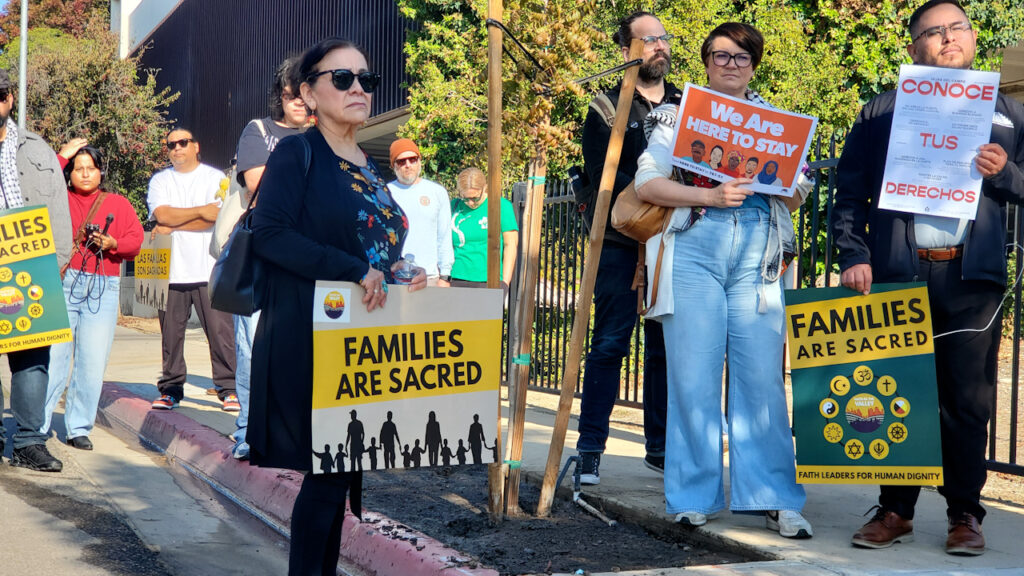John McCorry, a fourth-generation farmer, faces mounting losses from a devastating flood in 2023. (The Merced FOCUS/Christian De Jesus Betancourt)

- McCorry's pistachio orchard suffered significant damage, with 20% of his nut-bearing trees impacted.
- He estimates losses of over $300,000 in yield this year and anticipates a decade-long recovery process.
- McCorry has joined a class action lawsuit against government agencies, alleging inadequate creek maintenance exacerbated the flood's impact.
Share
|
Getting your Trinity Audio player ready...
|
John McCorry always knew he was destined to be a farmer ever since the first day he was old enough to get his hands dirty from working the land.

Christian De Jesus Betancourt
The Merced FOCUS
There’s no denying it’s in his blood. He’s the great-grandson of William McCorry, an Irish immigrant who first settled and farmed this land north of Planada in the late 19th Century.
Today, McCorry, 60, manages the family farm alongside his son John Jr., 39, keeping the family deeply connected to the soil.
“My aunt still owns that tabletop, that flat hill,” McCorry pointed out, gesturing towards the nearby mountains. My mom lives over there.”
The McCorrys were alfalfa farmers for many years. They switched to pistachios to use less water in 2014 after then-Gov. Jerry Brown signed the Sustainable Underground Groundwater Management Act into law.
But on Jan. 9 2023, the orchards planted on this historic land faced a devastating force of nature.
Nestled beside Miles Creek, the McCorry family’s pistachio trees were submerged under floodwaters after an atmospheric river brought unprecedented storms to the area. That caused the creek’s banks to overflow.
While there have been many reported stories about the thousands of Planada residents who suffered great losses from the flood, the losses suffered by farmers like McCorry are lesser known to the public.
Even though it’s been more than a year since the flood, McCorry said his losses have continued to mount. With 20% of his nut-bearing trees damaged, McCorry’s once-thriving orchard of 10,000 took a severe blow.
“We’ve lost over $300,000 in yield this year,” he said. “It’ll probably be a decade before we recover.”
McCorry refrained from speculating on the total cost of the flood’s impact as he continues to assess the full extent of the damage. “The only reason to stop would be to go broke,” he said. “I’m not in a good financial position right now.”
Thousands of gallons of water from Miles Creek are shown flooding John McCorry’s orchard in 2023. Photo courtesy of John McCorry Sr.

Lawsuits for the Flood
Still, McCorry says he’s actively seeking compensation for those losses. He’s among several plaintiffs who’ve filed civil lawsuits alleging that numerous government agencies were derelict in keeping the county’s creeks adequately maintained.
Some of the suits allege permitting was delayed to clear debris and vegetation from the creeks, resulting in areas where water clogged or overtopped banks and levees.
McCorry is one of about 100 plaintiffs in a class action lawsuit filed in Merced Superior Court in December 2023 by Los Angeles-based Kabateck LLP and Sacramento-based Ehlers Law.
He and the other plaintiffs allege Merced County, City of Merced, Merced Irrigation District, California Department of Fish and Wildlife, and California Fish and Game Commission are responsible for the flood damage.
In the suit, homeowners, renters, business owners and others say they suffered substantial losses in areas where the levee failed.
McCorry and the other plaintiffs want compensation for damaged property crop loss and several additional impacts that resulted in lost income. According to the suit, despite having the expertise to manage the water channels properly, the defendants prioritized cost savings over safety, exacerbating the flood’s impact on the community.
None of the attorneys representing the governmental entities responded to requests for comment directly about McCorry’s suit.
Flooding Was Continuous and Persistent
McCorry recently took The Merced FOCUS on a tour of his property to see the extensive damage.
“This was all under water,” he said, pointing to the center of his orchard. “You can see how the water took the topsoil.”
McCorry says his property suffered from persistent flooding even in the subsequent months after the Jan. 9 storm.
“We flooded three times out here because they never finished cleaning our creek or fixing that break,” McCorry said, pointing at an area of Miles Creek where the water had come pouring through.

“We were pumping the water out, but there was too much water coming in. Those breaks were pouring in thousands and thousands of gallons per minute — probably 10,000 to 20,000 gallons a minute.”
McCorry recalled how the creek’s overflow and broken levees created a funnel effect on his land, channeling floodwaters toward Planada.
“The water was going over the road,” he said. “It got higher after it stopped raining. Then, it broke closer to Planada and kept breaking in different places. It was too much water. It just went everywhere at that point.”
McCorry lamented the state of the trees that suffered the most damage due to the standing water.
“We had to cut some of the limbs off,” he said. “They rotted the roots since oxygen couldn’t get to them. Some of them are trying to come back. About 200 are dead. Probably about 2,000 trees got affected.”
While acknowledging the need for water during a drought, McCorry said, “We needed water, just not all at once.”
Flood Impacts on Pistachio Production
According to Robert D. Banks, an agricultural biologist with the Merced County Department of Agriculture, the 2023 disaster report revealed 250 of the 280 acres of pistachios in the Planada and Le Grand areas suffered damage, amounting to about $1 million in losses.
Elizabeth Fichtner, a farm advisor for the University of California Cooperative Extension, said studies have shown pistachio trees experience a significant increase in yield during their initial years of production.
Yields typically rise from 600 pounds per acre in the first producing year to 1,300 pounds in the second, about 2,200 in the third, and over 2,800 when the trees reach maturity, she said.

McCorry explained that when his pistachio trees began producing in 2019, they yielded about 200 pounds per acre.
The following year, production increased to 800 pounds. Then, in 2021 and 2022, he collected around 2,300 pounds.
McCorry anticipated he would have a higher pistachio yield in 2023 than in previous harvests, as his orchard was entering a more mature phase. However, no one expected the disaster that would follow.
“We went all the way down to 1,200 pounds,” he said. “We were expecting them to produce about 3,000, maybe even 4,000. We had a significant loss of income.”
Challenges and Hope for Future Harvest
As the 2024 harvest cycle continues, McCorry fears the orchard will not reach its true potential.
“We’ll start harvesting in October, and I can tell we’re going to get about 1,200-1,500 pounds,” he said. “I’m hoping next year we’re at least at 2,500. We’ve had to cut off so many trees that I don’t know that this orchard will ever produce like it was supposed to.”
Professional horticulturists hired by McCorry have assessed what it will take to revive his orchards. The plan involves replanting hundreds of trees and developing a new watering method.
“I’m going to have to wait 10 years for them to get to the point where those were, and that’s not counting the replant cost,” he said. “We have to do something different with the irrigation system, which isn’t going to be cheap.”
Adding new trees to an existing orchard can be very costly due to the irrigation process needed for younger trees compared with more mature trees.
“The problem is that a mature tree uses a lot more water than a little tree,” said Fichtner. “If you end up overwatering the little trees … they end up stunted. It would just be a huge challenge.”
To combat his losses, McCorry planted another 80 acres in another part of his property; however, those trees are not expected to yield nuts for a few more years.
Many Planada Residents Await Relief
When floods devastated the community of Planada, many people banded together to help the affected residents at the center of the community.
Disaster declarations were issued, and the federal government became involved, assisting those impacted.
“FEMA said they would give us a $100,000 loan, and I probably should have taken them up on that offer,” McCorry reflected.
Later that year, state Sen. Anna Caballero and Assemblymember Esmeralda Soria worked together to secure $20 million in state funds to aid those affected by the flood.
A year after the flood, Merced County Supervisors passed a resolution to distribute aid to affected residents and businesses.
“I applied for the maximum amount of $100,000 for businesses,” said McCorry. “I’ll be lucky if I get half of that.”
The application process officially began in March, and funds started to be distributed in July, a crucial support for many still grappling with the flood’s aftermath.
Miles Creek Today
After the flood, vegetation around Miles Creek was cut down to prevent future flooding. However, the regrowth of this vegetation could cause issues if another flood occurs.
“They said we’re not supposed to touch it because of the environmental impact, but then who does?” McCorry questioned.

McCorry hopes for some respite with his lawsuit, though he acknowledges that a resolution may be five or six years away.
“I don’t know exactly what happened, but somebody somewhere along the line messed up,” he said. “It’s the same story up and down the whole state. There are a lot of creeks that haven’t been maintained like they should have been.”
The road to recovery for McCorry’s orchard remains long and uncertain. In the meantime, he is focusing on tending to his trees and evaluating which ones might survive the damage.
“We’re trying to make sure that the trees get what they need,” he said. “Maybe it’s fertilizer. We have put on some root treatments, and we probably need to do more.”
As McCorry awaits developments regarding the $20 million in state recovery funds and his ongoing lawsuit, he also expresses hope for measures to prevent similar flood damage.
“The creeks don’t need to be maintained every year, but if they do it every three or four years and they’re being monitored, we should be okay,” he said.
The combination of revenue loss and the deteriorating health of the trees has deeply affected McCorry. As he described the current state of the orchard, his tone reflected the weight of the situation.
“This part is bad; this part of the whole orchard was beautiful,” he said, pointing at trees missing limbs and foliage.
“I get depressed. I don’t sleep very well anymore worrying about the lost revenue and the tree’s health. I don’t even like coming out here anymore because we worked so hard to make this a nice orchard for three months of rain to kill it.”

About the Author
As the bilingual community issues reporter for the Merced Focus, Christian De Jesus Betancourt is dedicated to illuminating the vibrant stories of the Latino Community of Merced. His journey is deeply rooted in the experiences of migration and the pursuit of a better life.




















